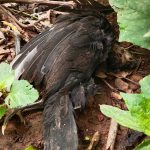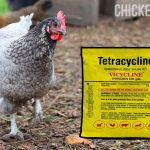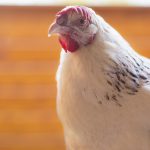Canker in Chickens
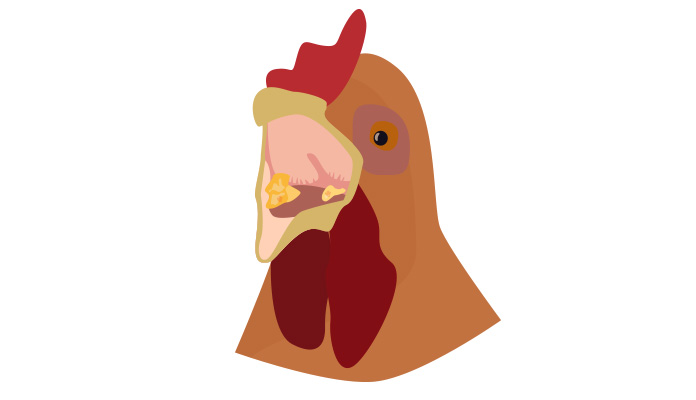

Canker in chickens is a widespread parasitic disease known for its cheesy yellowish patches in the back of a chicken’s mouth, ranging from mild to severe. Extreme strains of the parasite can cause a devastating disease. Luckily enough, there is medication available.
Let’s look at canker in chickens and how to deal with it.
- What is canker in chickens?
- Symptoms of canker in chickens
- Diagnosis & similar diseases
- Transmission
- Treatment
- Prevention
- Trichomonas gallinae
- Summary
What is Canker in Chickens?
Canker or trichomonosis is a worldwide parasitic disease that causes canker-like sores in the back of a chicken’s throat. The sores can grow so big they completely block the throat. About 80-90% of pigeons and doves carry the parasite and pass it on by drinking from the chicken’s water or eating from their feed.
The parasite that causes canker is the protozoa Trichomonas gallinae, a microscopic single-celled intruder that’s neither a virus nor a bacterium. The same parasite affects many wild birds, including pigeons, finches, parrots, hawks, and eagles.
The severity of the disease fluctuates considerably based on the parasite strain and the infected birds’ age or immune status. Recovered birds may still carry the parasite but can’t get reinfected.
Left untreated, the disease can be fatal. Luckily, antibiotics are accessible and can be prescribed by a veterinarian. These medicines are most effective when given in an early stage. The disease gets harder to treat as time passes. If provided early, antibiotics can offer relief within one or two days.
Symptoms of canker in chickens
The symptoms may vary depending on the strain of the parasite. The most prominent clinical signs are the sores in the back of a chicken’s throat.
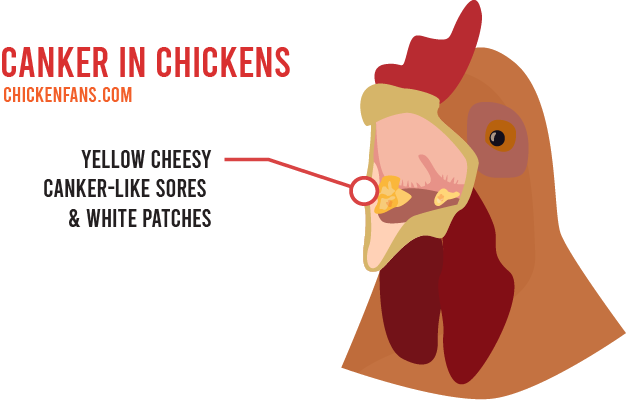
Symptoms of canker in chickens are:
- white and yellow cheesy canker-like sores in the mouth, beak, and throat
- difficulty swallowing and/or breathing
- swelling in throat, nostrils, and eyes
- difficulty eating, which can lead to starvation
- sometimes birds can’t close their beak
- yawning and gasping for air with an open mouth
- (greenish) diarrhea
- strong smelling breathe coming from the mouth
- drooling, sometimes with blood from the chicken’s mouth
- some birds have watery eyes
- reduced food and water intake, weight loss
- general lethargy, ruffled, dull feathers
In severe cases of trichomonosis, the sores can grow through the roof of the mouth, into the sinuses, inner ears, and even the bone at the base of the skull. These sores grow through the choanal slit, a pretty large, long opening in the roof of a chicken’s mouth that connects the mouth with the nostrils.
Diagnosis & Similar Diseases
Some people immediately think of canker when they see yellow patches in the mouth. However, a correct diagnosis can be challenging. The sores look very similar to the patches that develop after infection with the wet form of Fowlpox, Sour Crop, and other bacterial and fungal infections:
- Fowlpox is a severe infection that is caused by the avian pox virus. Chickens can get the wet form of Fowlpox by inhaling or ingesting infected dust particles in the form of aerosols.
- Sour crop, also called thrush or candidiasis, is a yeast infection of the crop, a little pocket on the back of the throat that buffers the food a chicken eats. The yeast is a Candida fungus that occurs naturally in the microflora but can grow out of control.
| Canker | Fowlpox (wet form) | Sour Crop | |
|---|---|---|---|
| disease | parasitic infection affecting the mouth and throat | viral infection affecting the upper respiratory system and digestive system | yeast infection affecting the chicken’s crop |
| type of sores | yellow cheesy canker-like sores | ulcerous cheesy white/yellow patches | white patches |
| germ cause | protozoa | virus | yeast |
| pathogen species | Trichomonas Gallinae | avian pox virus | Candida Albicans |
| other names | trichomonosis, frounce roup | avian diphtheria | thrush, candidiasis |
| origin of the infection | pigeons and doves drinking from the chicken’s waterers and eating from the feeders | initial infection from mosquito bites results in scabs, dust particles from those scabs that can be inhaled via aerosols | stress, improper diet, long periods of antibiotics, parasites, underlying health issues |
| treatment | antiprotozoal agent e.g. Metronidazole | no treatment (antibiotics to prevent secondary infections) | antifungal drugs e.g. Nystatin, copper sulfate |
A correct diagnosis is important since the treatment depends on the disease. Only a veterinarian can make an accurate diagnosis by taking a smear of the throat for microscopic examination.
Transmission
Most chickens and turkeys get infected when pigeons and doves drink from their waterer or eat from their feeders. Almost all doves and pigeons carry the parasite in their sinuses, mouth, throat, and other organs. They also pass the infection to their offspring by feeding them milk.
Since all the chickens drink from the same water and eat from the same feeder, it can result in a sudden outbreak. Luckily, the parasite can only survive for a few hours in water. However, it can survive for five days in moist food.
Transmission inside the flock
The parasite T. gallinae lives in the back of the throat, and chickens may carry it around for more than a year. When the chickens get sick and walk around with big sores, they can have difficulties swallowing. They sometimes pick up food and then drop it back on the ground. The food or water is then contaminated and can be picked up by other chickens.
The chicken droppings contain T. gallinae too. Chickens can get infected by contaminated bedding, food, soil, or drinking water and develop canker symptoms.
The parasite can also spread during mating or courtship by direct contact. There is no vertical transmission from the hen to the egg.
Is canker in chickens contagious to humans?
No, canker in chickens (trichomonosis) is not contagious to humans. Canker is caused by the protozoan parasite Trichomonas gallinae, which can not infect humans. The Trichomonas variant that causes trichomoniasis, a vaginal sexually transmitted disease, is caused by Trichomonas vaginalis, a different parasite.
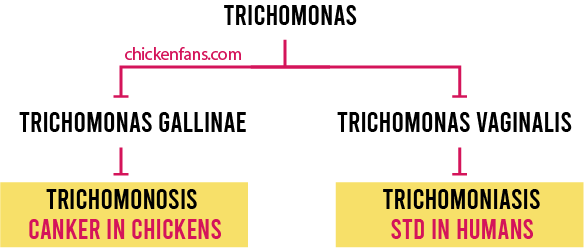
Treatment
Canker can be treated with anti-parasitic medication, such as metronidazole (60 mg/kg body wt), carnidazole (10 mg/kg body wt), and dimetridazole (50 mg/kg body wt) via oral route or in drinking water with 0.05% concentration for 5–6 days. These methods have good results even after a couple of days. The drug must be added to the water or feed.
If you don’t have immediate access to antiprotozoal agents, garden thyme extract (Thymus Vulgaris) can also be used for its anti-parasitic effects.
Separating the flock from wild birds and restricting access to feed and water sources is essential. Most parasite strains are also susceptible to heat and drying out. It’s a good idea to clean feeders and waterers and let them completely dry out.
Prevention
The most important part of prevention is to prevent doves, pigeons, and other birds from accessing the chicken’s feed and water.
Other measures you can take to avoid infections:
- routinely disinfect the feed and water sources with 10% bleach solution and let them completely dry out for a couple of days
- prevent wild birds from accessing storage facilities where you store feed
- prevent chickens from accessing natural water sources that wild birds drink from
- separate new birds and young birds from the flock before merging them in
Birds recovering from mild strains will build immunity to more virulent parasite strains.
Some sources recommend supplying apple cider vinegar to drinking water for its antimicrobial properties. However, no scientific evidence supports this recommendation for the control of canker. Proper sanitation and biosecurity measures are the best way to control and prevent trichomonosis.
Trichomonas gallinae
The hostile T. gallinae parasites that cause trichomonosis are protozoa. These single-celled microorganisms look like big bacteria but come with their own set of exotic cell structures. They are neither animals nor plants. Scientists gave them their own classification with the latest species taxonomy published in 2000.
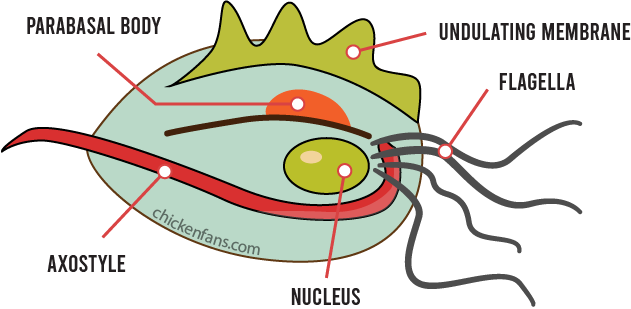
Trichomonas have long leg-like flagella that they use to swim around in the body. The undulating membrane works as a fin. They have a flexible axostyle that starts at the base of the flagella and runs beyond the end of the cell. Scientists think the axostyle has a function in locomotion. They also have a parabasal body, a bulge, that nobody knows what it’s there for.
Dinosaurs
The parasite is so old it was already infecting the Tyrannosaurus rex and other bird-like dinosaurs 70 million years ago. Paleontologists believe that some of the Tyrannosaurus rex they found died from trichomonosis. They had such severe trichomonosis-related lesions that they most probably died through starvation.
It’s no wonder the parasite still infects birds and chickens. They are dinosaurs, after all.
Life Cycle
When a chicken ingests the parasite, it starts to replicate. Every protozoan splits in half over its length, creating two new parasites, a process which is called longitudinal fission.
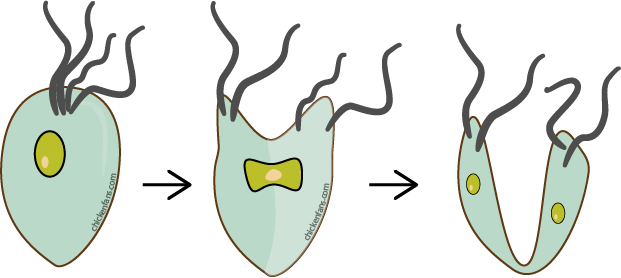
The organism nests itself in the chicken’s throat, crop, and stomach. It feeds upon bacteria, dead cells, and pus and is actually cleaning up the chicken’s body. Mild infections can go unnoticed.
This form, where they are mobile and can attach to the body’s surface, is called a trophozoite.
Virulent Strains
Virulent strains of Trichomonas also eat healthy tissue and produce their own protein debris. This triggers a response from the immune system, creating even more pus for the parasite to feed on. The result in chickens is canker with yellow patches you can see growing in the back of the mouth.
In most cases, the protozoa stay on the surface of the organs. But sometimes, they damage the tissue so much that they can eat themselves through the outer tissues and enter organs. Some of the Trichomonas gallinae strains that affect chickens are so strong that they can eat through the roof of the mouth and invade the brain.
Spread of canker outside of the body
The good news is that the parasite is not so robust when it needs to survive outside the body. Other protozoa, like coccidia in coccidiosis, form a hard-shelled cyst that can survive long in dirty soil. T. gallinae, however, only forms a pseudocyst. It transitions from trophozoite to cyst, but the resulting parasite egg is not resistant at all.
The parasite can only survive a couple of hours in water and up to a day in the soil. It’s also very susceptible to drying out in hot weather conditions.
Summary
Canker or trichomonosis in chickens is a global parasitic disease that causes canker-like sores in the back of a chicken’s throat. The white and yellow patches are caused by the protozoa Trichomonas gallinae. A parasite that already affected bird-like dinosaurs 70 million years ago.
When the patches in the back of the throat grow too big, they can block the throat, making it difficult to drink and eat. Antiprotozoal medication can treat canker, but it can be challenging to diagnose the disease in the first place. The symptoms resemble other conditions like the wet form of Fowlpox and Sour crop. Only a vet can make a correct diagnosis.
Most pigeons and doves are carriers of the disease. To prevent canker, don’t allow wild birds to eat from the chicken’s feed or drink from the same water.
If you want to read more about chicken health problems, symptoms, and diseases, check out our ‘Health Page‘. You’ll find a ‘Symptom Checker‘, a complete list of ‘Chicken Behavior‘, and an overview of the most common ‘Chicken Diseases‘. Or go to ‘The Classroom‘ and find a comprehensive list of all Chicken Fans articles.

Dr. Emiechelle R. is a licensed veterinarian and an bachelor in Science in Animal Husbandry. She works as a veterinarian specializing in poultry production and medicine including layers, broilers, ducks and quails.


